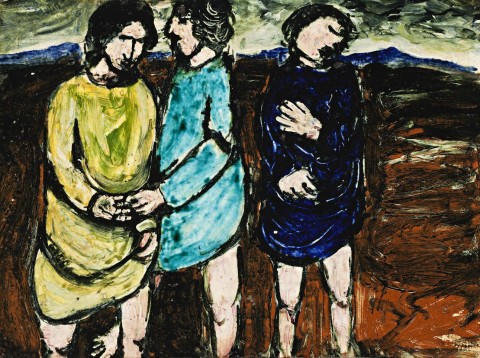THE TRIBUTE MONEY, c.1950 – 52
ARTHUR BOYD
glazed ceramic tile
33.0 x 44.0 cm
Peter Bray Gallery, Melbourne (labels attached verso)
Gerald Griffin, Melbourne, acquired from the above in 1952
Thence by descent
Private collection, Melbourne
Thence by descent
Private collection, Melbourne
Ceramic Paintings by Arthur Boyd, Peter Bray Gallery, Melbourne, 26 August – 4 September 1952, cat. 24
The Thirty Pieces of Silver, c.1950, ceramic painting, illus. in Philipp, F., Arthur Boyd, Thames and Hudson, London, 1967, pl. 55, cat. 6.9
The career of Arthur Boyd is distinguished by his mastery across media, be it painting, drawing, printmaking or ceramics. The son of Australia’s first studio potter Merric Boyd, Arthur learnt by example and then through his own experimentation on his father’s equipment at the family compound known as ‘Open Country’. In 1944, he formed his own business, AMB Pottery, in partnership with his brother-in-law John Perceval and their colleague Peter Herbst. Sited in a former butcher’s shop in Neerim Road, Murrumbeena, the pottery utilised some of Merric’s old machinery bolstered by a new gas kiln, stillage and electric wheel. The immediate aim was mass manufacture of utilitarian crockery to meet the demand caused by wartime shortages but once released from these restrictions, they set about making earthenware to their own design with under-glaze painted decorations featuring flowers, animals and joyous, boisterous scenes. Concurrently, Boyd was also painting significant works such as The Mockers and The Mourners, both 1945, based on biblical stories, before transferring similar narratives onto clay in an interlinked suite of ceramic tiles of which The Tribute Money, c.1950 – 52, is a fine example.
The mid-1940s was also the period when the young artist became enamored of the imagery of Rembrandt and the Flemish artists Pieter Brueghel and Hieronymus Bosch, and the paintings from his ‘biblical period’ bear witness to these influences. The simplified passages of rich colour in the paintings of Tintoretto further informed Boyd’s painterly techniques at the time. With the added impetus of his involvement in the AMB Pottery, he started experimenting with an ‘idiosyncratic’ combination of oxides and slip mixed to the consistency of oil paint.1 Boyd was quickly dazzled by the results, recalling in later years his excitement as he took the first tile out of the kiln: ‘It was the most marvelous feeling … a painting doesn’t have anywhere near the impact of pulling something out that has been almost purged by being through fire…. It is a pure object and it is changed. It’s formed in the fire and so the surprise is marvelous’.2 Between 1949 and 1953, Boyd created multiple, richly glazed tiles on subjects as diverse as Jonah and the whale, the prodigal son, Moses and the tablets, and Europa and the bull, each with the intense colouration of stained glass.
Boyd’s first biographer, Franz Phillip, noted that the use of ceramic tiles provided the artist with ‘a field of threefold experimentation: colouristic, compositional and iconographic’ and that he displayed ‘a preference for two or three figures, for a dominant pictorial rhythm, a strong telling and pervading gesture’,3 all aspects evident in The Tribute Money. This tile illustrates an incident within the life of St Peter as described in the Gospel of Matthew, when Jesus directs Peter to find a coin in the mouth of a fish in order to pay the temple tax imposed by the Romans. Two figures covertly pass the coin whilst a third looks away, either cautious or abashed by his companion’s kowtowing to the imperialist authorities. With its simplified figures adorned in cloaks each of a single colour, The Tribute Money is both an amalgam of Boyd’s artistic influences and a strikingly individualistic response to their original examples.
1. See Pearce, B., Arthur Boyd: retrospective, Beagle Press, Sydney, 1993, p. 170
2. Arthur Boyd, 1993, quoted in Pearce, B., op. cit., p. 169
3. Philipp, F., Arthur Boyd, Thames and Hudson, London, 1967, p. 68
ANDREW GAYNOR
